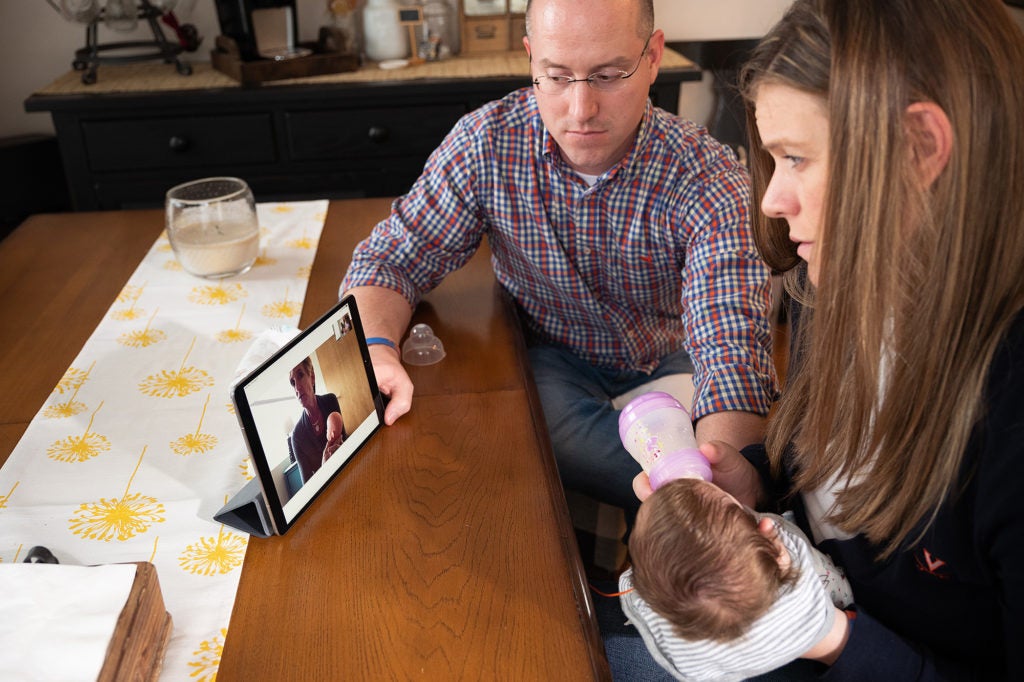By Jeffrey Vergales, MD & Brooke Vergales, MD
Q: Please briefly summarize your iPad program.
Jeff: We run a remote monitoring program for high-risk populations. Four years ago, we developed and integrated a platform that can connect to a medical record here at the Children’s Hospital. Now, parents can enter information and it transfers directly to their record. We can treat high-risk kids across the Commonwealth as if they were in the hospital. We started with high-risk kids with cardiac issues, then chemotherapy, then cystic fibrosis, and now premature infants. Our next goal is to help kids receiving solid organ transplants.
Q: What was the light bulb moment when you realized your current system wasn’t working?
Jeff: I was constantly frustrated that we had incredibly high standards of care for high-risk kids at the hospital, but we would instantly send them home. The risk profile was exactly the same but how we dealt with them was so different. The monitoring system was a piece of paper and a pen. We needed to create a system that was compliant and secure and served our patients in a better way. Now, the transition to home is easier and, more importantly, we reset the standard for discharge. These families can do everything from home while we keep an eye on things from here.
Brooke: I was saddened on rounds when the team was reporting the babies oral intake percentage and you would see the defeat on the parent’s face. They knew this was the last thing their baby had to do in order to get home and every day they felt like time was dragging as their infant developed this skill. At the same time the unit was extremely busy and we were turning away babies that really needed our care. I realized that we could send these babies home to continue to work on their oral skills with their families if we had a way to monitor them similar to the way we were monitoring them in the hospital.
Q: What was the time frame between your idea to the launch of the app?
Jeff: From “hey, let’s do something” to actually enrolling patients took about 9 months.
Q: How did Apple get involved?
Jeff: We developed the app with Locus Health and started getting momentum as other hospitals came on board. The VP of Healthcare at Apple saw an article about it and reached out to me directly. I went to Las Vegas and spoke at a big conference about how the Children’s Hospital is using Apple products. That lead to Apple coming to us to shoot a profile video. Now, we share ideas and help each other.
Q: How many children have you served with this technology?
Jeff: We’ve sent about 45 -50 babies home with iPads in the NICU. Across the Children’s Hospital, we’ve served close to 150 kids. There are also about 15 other hospitals that have started using this technology.
Q: Tell me about the collaboration with your wife/husband.
Jeff: Every one of our populations needs a clinical champion. You can’t just throw technology at a problem. You need somebody that is utilizing the system. Brooke was very interested in how this system could benefit NICU patients and it made sense that infant care would be the next step in expanding.
Brooke: Jeff is the idea guy. He is always looking at problems through a different lens and thinking how we can improve what we are doing. When I went to him with my idea of making this work in the NICU his response was, “let’s do it!”
Q: How do you define innovation?
Jeff: To me, innovation is not just accepting that the way we’ve always done it is the best way. I believe in always exploring newer and well-thought-out mechanisms. We shouldn’t assume we don’t need to change. We really had to think about what appropriate discharge meant. We thought through when patients needed to be in the hospital vs at home with the tools and support they needed.
Q: What have you learned that you’d want to share with others in the department?
Jeff: There are so many issues that can benefit from technology like this, but you need an innovative system behind it. This is not just sending a kid home with iPad. This is successful because we have the foundation – how to analyze and use the data, how to educate and work with parents. The beauty of what we created is in our clinical system and how we deploy it.
Q: What has been the most exciting part of this project?
Jeff: The momentum. We’ve grown rapidly in the world of healthcare. Better yet, we’ve had SO many parents reach out to say how important this is. There has been a better transition to home, especially for kids that have been in the hospital for a long time. That has been the most exciting part.
Brooke: The most exciting part of this program for me has been the families’ response. Discharging a patient is the most rewarding thing that I do, especially when the baby has been hospitalized for a few months. These families have felt empowered to be a part of their child’s care. Another exciting thing about this program is watching the excitement around it grow among the entire care provider team including the nursing staff, the case managers, and the speech therapists.
Learn more
Interested in learning more? Contact Jeff at JEV6K@hscmail.mcc.virginia.edu and Brooke at BLD5J@hscmail.mcc.virginia.edu.
- People Magazine Article, March 2019: https://people.com/health/doctors-ipad-program-nicu-babies-get-home-faster/
- Apple Healthcare: https://www.apple.com/healthcare/

Filed Under: Features
